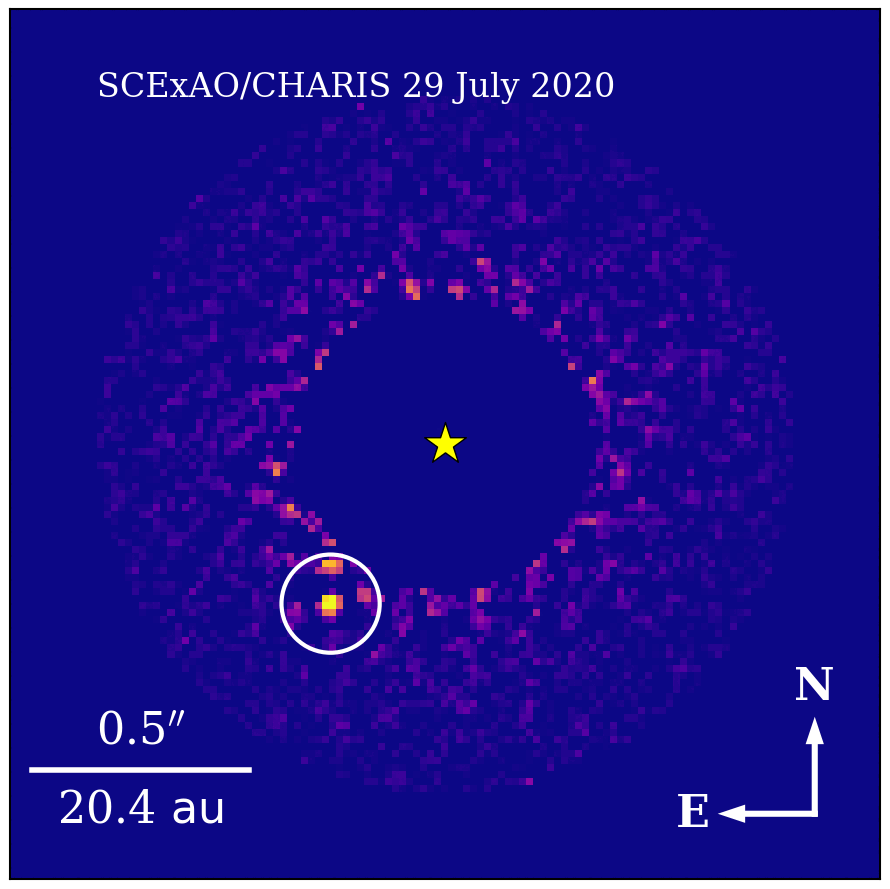
APRIL 13, 2023 — An international research team led by UTSA associate professor of astrophysics Thayne Currie has made a breakthrough in accelerating the search for new planets.
In a paper slated for publication April 14 in Science, Currie reports the first exoplanet jointly discovered through direct imaging and precision astrometry, a new indirect method that identifies a planet by measuring the position of the star it orbits. Data from the Subaru Telescope in Hawai`i and space telescopes from the European Space Agency (ESA) were integral to the team’s discovery.
An exoplanet—also called an extrasolar planet—is a planet outside a solar system that orbits another star. With direct imaging, astronomers can see an exoplanet’s light in a telescope and study its atmosphere. However, only about 20 have been directly imaged over the past 15 years.
By contrast, indirect planet detection methods determine a planet’s existence through its effect on the star it orbits. This approach can provide detailed measurements of the planet’s mass and orbit.
Combining direct and indirect methods to examine a planet's position provides a more complete understanding of an exoplanet, Currie says.
“Indirect planet detection methods are responsible for most exoplanet discoveries thus far. Using one of these methods, precision astrometry, told us where to look to try to image planets. And, as we found out, we can now see planets a lot easier,” Currie said.

The newly discovered exoplanet, called HIP 99770 b, is about 14 to 16 times the mass of Jupiter and orbits a star that is nearly twice as massive as the Sun. The planetary system also shares similarities with the outer regions of our solar system. HIP 99770 b receives about as much light as Jupiter, our solar system’s most massive planet, receives from the Sun. Its host star is surrounded by icy debris left over from planet formation, similar to our solar system’s Kuiper belt, the ring of icy objects observed around the Sun.
Currie and team used the Hipparcos-Gaia Catalogue of Accelerations to advance their discovery of HIP 99770 b. The catalogue consists of data from ESA’s Gaia mission and Hipparcos, Gaia’s predecessor, providing a 25-year record of accurate star positions and motions. It revealed that the star HIP 99770 is likely being accelerated by the gravitational pull of an unseen planet.
The team then used the Subaru Coronagraphic Extreme Adaptive Optics (SCExAO) instrument, which is permanently installed at the focus of the Subaru Telescope in Hawai`i, to image and confirm the existence of HIP 99770 b.
The discovery of HIP 99770 b is significant, because it opens a new avenue for scientists to discover and characterize exoplanets more comprehensively than ever before, Currie said, shedding light on the diversity and evolution of planetary systems. Using indirect methods to guide efforts to image planets may also someday lead scientists closer to the first images of other Earths.
“This is the first of many discoveries that we expect to have. We are in a new era of studying extrasolar planets,” Currie said.
UTSA Today is produced by University Communications and Marketing, the official news source of The University of Texas at San Antonio. Send your feedback to news@utsa.edu. Keep up-to-date on UTSA news by visiting UTSA Today. Connect with UTSA online at Facebook, Twitter, Youtube and Instagram.
Move In To COLFA is strongly recommended for new students in COLFA. It gives you the chance to learn about the Student Success Center, campus resources and meet new friends!
Academic Classroom: Lecture Hall (MH 2.01.10,) McKinney Humanities BldgWe invite you to join us for Birds Up! Downtown, an exciting welcome back event designed to connect students with the different departments at the Downtown Campus. Students will have the opportunity to learn about some of the departments on campus, gain access to different resources, and collect some giveaways!
Bill Miller PlazaJoin us for an intimate evening of cocktails, conversation, and culinary inspiration with Pati Jinich, Emmy-nominated chef and James Beard Award-winning author. Enjoy light bites and signature drinks in the warm, modern setting of Mezquite as Pati connects with guests over her passion for Mexican cuisine and storytelling.
Mezquite Restaurant in Pullman Market, 221 Newell Ave., San Antonio 78215From inspired courses to thoughtful pairings and a rich sense of community, the Ven a Comer Signature Dinner is a night of shared meals, shared stories, and unforgettable flavor.
Stable Hall (Pear Brewery), 307 Pearl Pkwy, San Antonio 78215Come and celebrate this year's homecoming at the Downtown Campus with food, games, giveaways, music, and more. We look forward to seeing your Roadrunner Spirit!
Bill Miller PlazaThe University of Texas at San Antonio is dedicated to the advancement of knowledge through research and discovery, teaching and learning, community engagement and public service. As an institution of access and excellence, UTSA embraces multicultural traditions and serves as a center for intellectual and creative resources as well as a catalyst for socioeconomic development and the commercialization of intellectual property - for Texas, the nation and the world.
To be a premier public research university, providing access to educational excellence and preparing citizen leaders for the global environment.
We encourage an environment of dialogue and discovery, where integrity, excellence, respect, collaboration and innovation are fostered.